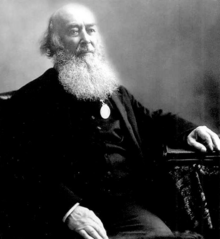Charles Chiniquy

Charles Paschal Telesphore Chiniquy (30 July 1809 – 16 January 1899) was a Canadian
Chiniquy founded the
Biography
Chiniquy was born in 1809 to a
Later he immigrated to
Chiniquy clashed with the Bishop of Chicago,
He asserted that Catholicism was Pagan, that Catholics worshipped the Virgin Mary, and that its theology was anti-Christian.[9] He warned of plots by the Vatican to take control of the United States by importing Catholic immigrants from Ireland, Germany, and France. This was at a time of high immigration rates from those countries, in response to social and political upheaval (the Great Famine in Ireland and revolutions in Germany and France). Chiniquy claimed that he was falsely accused by his superiors (and that Abraham Lincoln had come to his rescue), that the American Civil War was a plot against the United States of America by the Vatican, and that the Vatican was behind the Confederate cause, and the assassination of U.S. President Lincoln, and that Lincoln's assassins were faithful Catholics ultimately serving Pope Pius IX.
After leaving the Catholic Church, Chiniquy dedicated his life to
Chiniquy died in
To this day, some of Chiniquy's works are still promoted among Protestant Christians and
St. Anne Colony
Chiniquy, then a Catholic priest, left Canada in the wake of a series of scandals. He was offered a fresh start by
Chiniquy had definitively left the Catholic Church in 1858,
Alexander F. Kemp was chairman of the Synod of the Canada Presbyterian Church committee that examined Chiniquy's application for admission as a minister.
In St. Anne, a religious society was incorporated in the state that was named the "Christian Catholic Church at St. Anne". It was classified as a Protestant religious association.[21] Two years later, when it joined the PCUSA in 1860, it took the name of "First Presbyterian Church of St. Anne".[22]
See also
Archives
There is a Charles Chiniquy fonds at Library and Archives Canada.[23] The archival reference number is R7160.
References
- ^ a b c d e f g h Ferland, Catherine (1 February 2020). "Charles Chiniquy, apôtre spectaculaire de l'abstinence à l'alcool". Aujourd'hui l'histoire (in French). Montreal: Ici Radio-Canada Première. Archived from the original on 17 October 2022. Retrieved 27 October 2022.
- ISSN 0022-4227.
- ^ "Newly acquired artifacts recall a revered and reviled priest". www.historymuseum.ca. Gatineau: Canadian Museum of History. 13 June 2016. Archived from the original on 23 October 2022. Retrieved 27 October 2022.
- ^ ISBN 978-3-73404-393-2.
- ^ from the original on 1 October 2012. Retrieved 27 April 2013.
- ^ George, Joseph. “The Lincoln Writings of Charles P. T. Chiniquy,” Journal of the Illinois State Historical Society, vol. 69, no. 1, 1976, pp. 17–25. JSTOR, JSTOR, www.jstor.org/stable/40191689.
- ^ ISBN 9780981168500.
- ISBN 978-0-230-60809-2.
- ^ Chiniquy, Charles (1886). Fifty Years in the Church of Rome. Fleming H. Revell. pp. 118–128.
- from the original on 2 June 2008. Retrieved 2 April 2013.
- ^ The Priest, The Woman and The Confessional[permanent dead link]
- ISBN 978-1-894667-93-7.
- ^ Beyond the Banners: The Story of the Orange Order, pg. 93
- Centre for Tasmanian Historical Studies. Retrieved 20 October 2023.
- OCLC 458759012.
- from the original on 6 April 2013. Retrieved 26 February 2022.
- ^ Smith, Sydney F. Rev. S.J., "Pastor Chiniquy...", Catholic Truth Society, London, 1908 p
- ^ from the original on 5 October 2012. Retrieved 27 April 2013.
- ^ "Seventh Biennial Report of the Superintendent of Public Instruction of the State of Illinois. 1867–1868". Reports made to the General Assembly of Illinois, at its twenty-sixth session, convened 4 January 1869. Vol. 2. Springfield: Illinois Journal Printing Office. 1869. pp. vi–vii, 212–214, 311–312.
- ^ from the original on 16 July 2012. Retrieved 27 April 2013. Reprinted from the Canada Observer.
- ^ Chiniquy v. Catholic Bishop of Chicago, 41 Ill, 148 (1866) ("It was stipulated on the trial of the issues, that there was at St. Anne, an incorporation of a religious society, by the name of the Christian Catholic Church at St. Anne, incorporated under the general law of this State.").
- ^ Caroline B. Brettell, "From Catholics to Presbyterians: French-Canadian Immigrants to Central Illinois," American Presbyterians 63.3 (Fall 1985): 285-298.
- ^ "Fonds Charles Chiniquy description at Library and Archives Canada". 25 November 2016. Retrieved November 10, 2022.
Bibliography
- Berton, Pierre (1976). My Country: The Remarkable Past. McClelland & Stewart. ISBN 9780771013935.
- Caroline B. Brettell, Following Father Chiniquy: Immigration, Religious Schism, and Social Change in Nineteenth-Century Illinois (Southern Illinois University Press, 2015).
- Richard Lougheed, The Controversial Conversion of Charles Chiniquy, Toronto, Clements Academic, 2009.
- Richard Lougheed, Charles Chiniquy : l'homme de controverse, Toronto, Clements Academic, 2015.(in French)
- Serup Paul, Who Killed Abraham Lincoln?, Prince George, Salmova Press, 2010.
- Marcel Trudel, Chiniquy, Trois-Rivieres, Editions du Bien Public, 1955.
